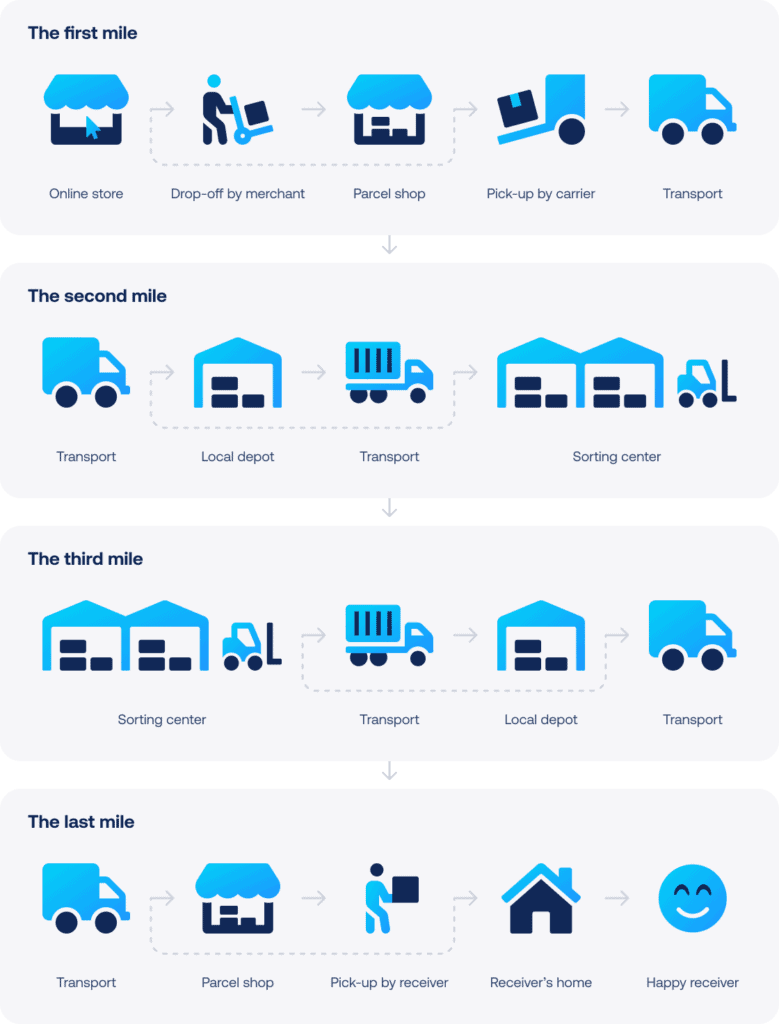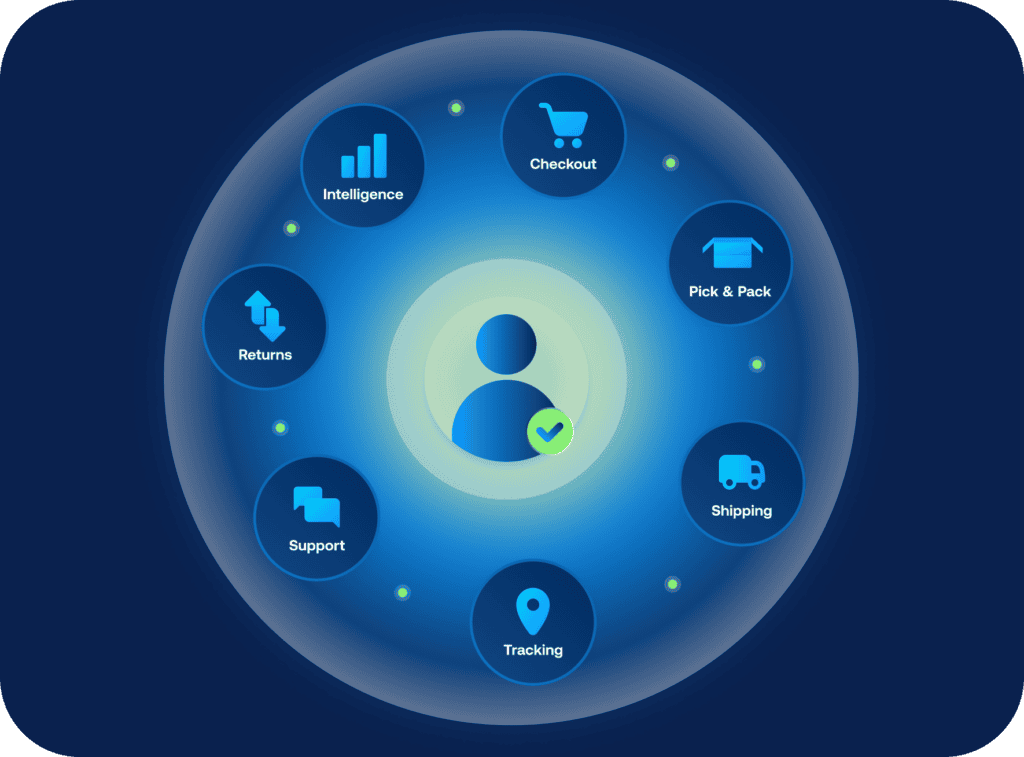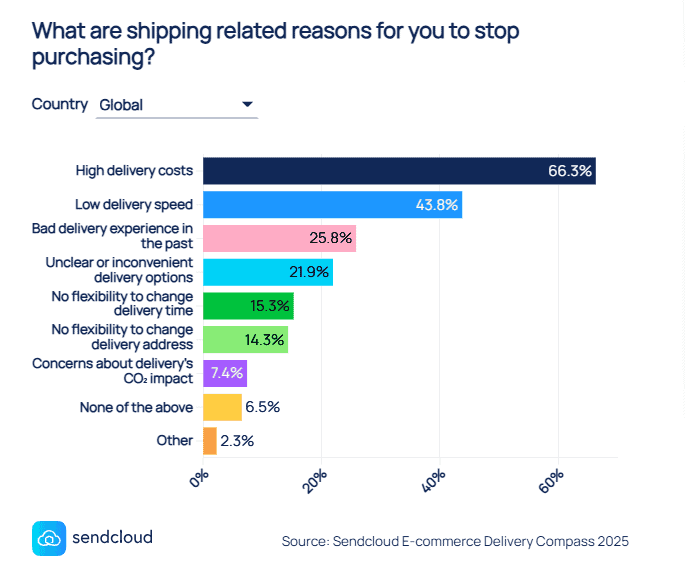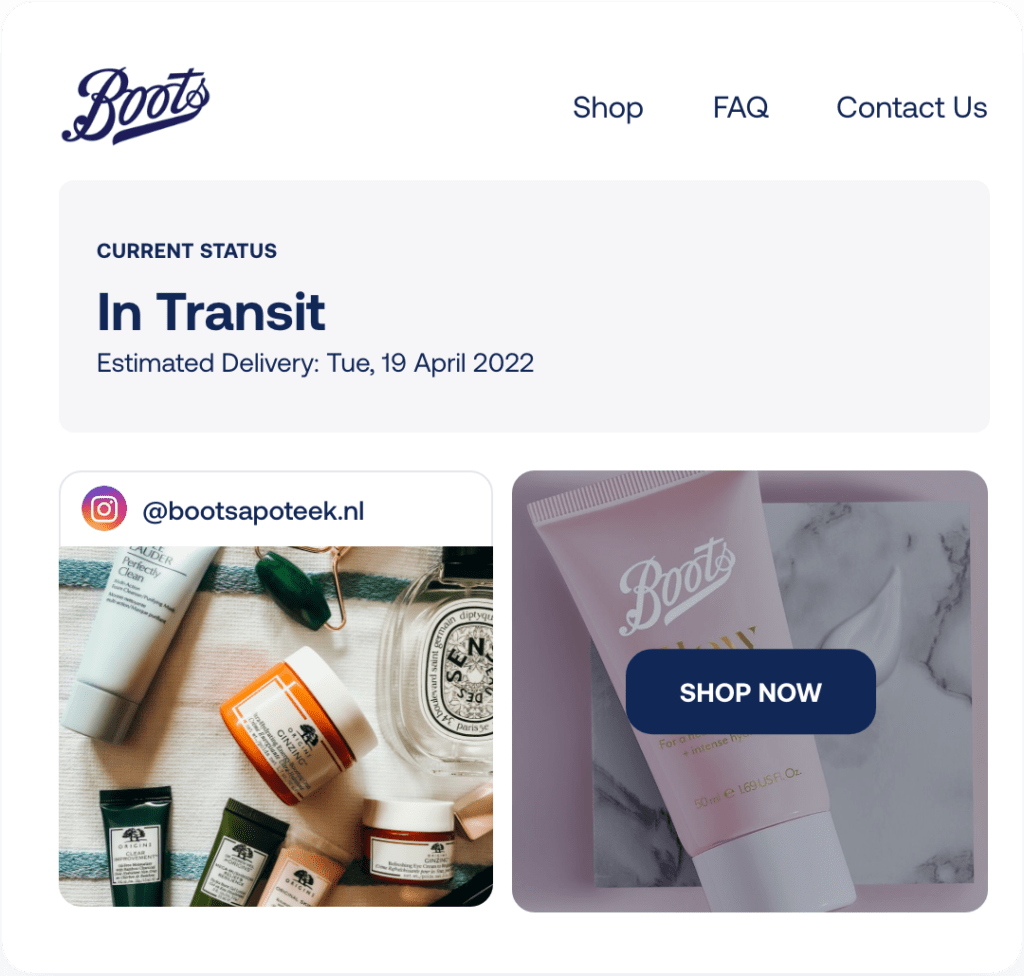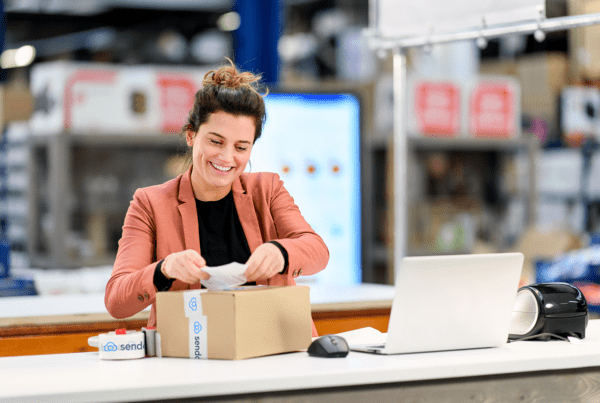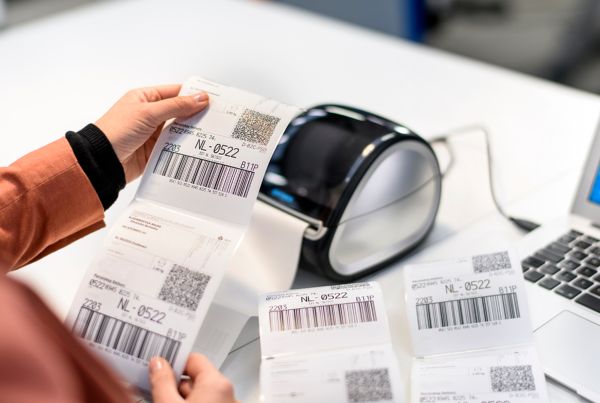Summary
Growing e-commerce merchants struggle with high shipping costs, manual errors, and over-reliance on single couriers, putting margins and customer trust at risk. By automating core workflows, adopting multi-courier shipping for flexibility, and creating branded, customer-centric delivery experiences, e-commerce brands can transform shipping from a cost center into a powerful driver of growth, retention, and competitive advantage
Shipping isn’t just backend ops anymore. It is your customer experience.
What used to be a cost line is now a conversion lever, influencing how often people buy, how long they stay loyal, and how loudly they rave (or complain). When 44% of carts are abandoned over shipping issues, and shoppers check tracking five times per order, you can’t afford to treat delivery like an afterthought.
This guide is your blueprint: what modern e‑commerce shipping really means, how to fix the biggest pain points, and what the fastest-growing merchants are doing differently.
What is e-commerce shipping? A quick definition
E‑commerce shipping is the full journey of an order after checkout, including order fulfilment, courier selection, delivery, tracking, and returns. It’s everything between the moment a customer clicks “buy” and the point they receive the product (or return it). It has evolved from a backend cost to one of the most visible and critical customer touchpoints — influencing conversions, loyalty, and even brand perception.
Core steps of e‑commerce shipping
Below are the essential steps that a modern shipping model must optimise to win today:
Step 1: Checkout
A great shipping experience starts at checkout. Offering clear delivery choices (standard, express, out of home), transparent costs (shipping + insurance + potential duties), and estimated delivery times. Missing or confusing options here lead to cart abandonment.
Step 2: Order receiving & processing
Capturing incoming orders from all your sales channels (like Shopify, WooCommerce, or marketplaces like Amazon), syncing them into one workflow, and triggering order fulfilment without delays or manual copy-paste.
Step 3: Picking & packing
Ensuring items are picked and packed correctly, safely, with branding (packaging, inserts, etc.). Good packaging: minimises damage, returns, and delivers a positive unboxing experience.
Step 4: Label creation & courier selection
Deciding which courier to use (cost, transit speed, reliability, destination), generating shipping labels (bulk vs single), possibly choosing based on business rules.
Step 5: Shipping insurance
Protecting parcels against loss or damage is a critical part of building customer trust. Insurance can be included or offered as an add-on, but the smart move is to automate it. For example, high-value goods or international shipments can be automatically insured, removing the manual decision each time and ensuring both merchants and customers are protected.
Step 6: Handover to courier
This is where responsibility shifts. It includes scheduling courier pickups, prepping for drop-offs, and ensuring parcels are scanned and handed off according to SLA (service level agreement). But it’s also where things can go wrong: delays, damage, or even loss. That’s why this step also includes initiating and tracking courier claims when issues occur, and automating refund recovery wherever possible.
Step 7: Tracking & notifications
Keeping customers informed via branded tracking pages, emails, WhatsApp or SMS; reducing uncertainty and WISMO (Where Is My Order) queries.
Step 8: Delivery / last‑mile
Final mile performance matters most: speed, whether delivery is to home or alternative (locker / service point), accuracy, and condition.
Step 9: Returns & refunds
The loop back: allowing easy returns (via portals, rules), tracking return status, integrating with refund or exchange policies. Making returns painless boosts trust and can increase repeat purchases.
The new role of shipping in e-commerce growth
Shipping used to be where profits went to die. Now? It’s where brands win or lose.
Fast-growing merchants have realised that shipping isn’t just the last step of an order, it’s the first impression customers remember. And the reason they come back.
Shipping has become a brand lever, just like your storefront, ads or packaging. Whether it’s flexible delivery options at checkout, branded tracking pages post-purchase, or a frictionless returns portal, the best merchants turn logistics into loyalty.
Shipping is now where customer experience lives and where competitors can’t easily copy you. Fast isn’t the only goal. Clear, reliable, branded and flexible is the new standard!
Biggest e-commerce shipping challenges for growing merchants
If you’re shipping 100 to 1,000 parcels a month, chances are you’re feeling the squeeze. The jump from startup to scalable ops can be brutal, especially if shipping still runs on manual tasks.
Here’s what holds similar companies like you back:
- Manual busywork: Still copy-pasting addresses, switching courier portals, chasing lost parcels? It’s not just inefficient, it’s costly.
- High shipping costs: Margins are thin, and without automation or courier flexibility, you’re likely overpaying.
- Courier dependency: One late delivery from a single courier shouldn’t wreck your brand. But without a fallback, it can.
- Returns chaos: When return flows are manual or unclear, you lose both money and customer trust.
- Cross-border complexity: Expanding beyond borders means dealing with customs, taxes, lockers, local delivery norms — and it’s rarely plug-and-play.
💡Our internal data shows that nearly half of SMBs (48%) now rank automated label generation as their top priority, while over a quarter (27%) see multi-courier access as the key to scaling. Both are clear signals: automation and flexibility are no longer optional, they’re the baseline for growth.
The good news? Winning merchants aren’t solving these challenges piecemeal, they’re adopting what we call Connected Shipping: an approach that connects automation, multi-courier flexibility, and customer experience into one strategy.
Key trends shaping e-commerce shipping in 2026 and beyond
The game has changed. Shoppers expect faster, greener, and more transparent delivery than ever before. And as we’ve seen in our e-commerce trends report, these expectations are only accelerating, shaping how merchants approach checkout, delivery, and post-purchase experience:
1. Rising consumer expectations
- Delivery choice: home, express, pickup point
- Proactive tracking (not just a code, but real updates)
- Easy returns (without emailing support)
They check tracking 5+ times per order. They abandon carts when delivery feels vague or slow. Shipping is no longer invisible, it’s how trust is built (or lost).
2. Multi-courier strategies = resilience
No single courier can deliver across Europe fast, affordably, and reliably. Smart merchants mix couriers, use rules to route shipments, and always have a backup.
3. Branded post-purchase experience
Shoppers don’t just track, they scrutinise. That makes the post-purchase experience with post-purchase emails, tracking pages, and return flows an additional marketing channel.
4. Sustainability & smart packaging
Eco-friendly shipping isn’t a bonus anymore, it’s expected. In fact, 52% of shoppers would choose one store over another if it offered more sustainable shipping options.
Offering recyclable packaging, right-sized boxes, and efficient delivery routes signals that your brand gets it. Even better? Sustainable shipping is often cost-efficient too. Fewer failed deliveries = lower costs and fewer complaints.
5. AI and automation as baseline
Manual shipping is over. No brand can scale if founders or small ops teams are still stuck in portals, copy-pasting addresses, or manually chasing lost parcels.
Automation and AI are changing the game: rules that choose the best courier, systems that auto-generate labels in bulk, tools that resolve claims in minutes instead of days. What used to eat up hours of manual work now happens in the background, freeing up merchants to focus on growth.
The real shift? Automation isn’t an upgrade anymore — it’s the foundation. Growing merchants that adopt it early stay lean, avoid errors, and build capacity without adding headcount. Those who delay risk drowning in support tickets and missed margins.
💡 You as a growing e-commerce merchant will likely never out-Amazon Amazon on raw speed. But you don’t have to. The real win is competing on transparency, branded experiences, and customer-centric delivery — turning every shipment into a loyalty driver.
How to win the shipping game
So, how do you actually turn shipping into growth? It comes down to three connected steps:
1: Automate the basics
The fastest path to scale is removing repetitive work. Shipping labels, tracking emails, and claims shouldn’t consume hours of your week. Automating these basics cuts errors, accelerates fulfilment, and protects margins.
2: Add flexibility to the mix
Resilience comes from choice. No single courier covers Europe efficiently, and relying on one leaves your business exposed to delays, price hikes, and poor service. Winning merchants diversify through multi-courier setups and use smart rules to route shipments automatically.
But flexibility isn’t just about couriers. Shoppers expect delivery options that fit their lives: home delivery, express shipping, pickup points, or lockers. Offering these choices directly at checkout reduces cart abandonment and signals that your brand puts customers first. Read more about flexibility in our latest E-Commerce Delivery Compass.
3: Close the customer experience loop
Shipping doesn’t stop at delivery. Every touchpoint after checkout, tracking pages, packaging, returns, is part of your brand. Branded tracking reduces support load and boosts trust. Sustainable packaging makes the unboxing memorable. Easy returns turn frustration into loyalty. Together, these touchpoints form a loop that keeps customers coming back.
Shipping success in today’s world isn’t about speed alone. It’s about building automation, flexibility, and customer-centric experiences into your operations, and treating shipping as a growth engine, not a cost.
How other merchants win with better e-commerce shipping
The best way to see the power of modern shipping is in action. Here are a few examples of growing merchants who turned delivery from a cost factor into a growth lever:
- WoodWatch: Expanded to 100+ countries after automating customs forms, cutting processing time in half.
- Le Colonel Moutarde: Streamlined fulfilment by automating shipping through PrestaShop and adding courier flexibility, making it easier to scale without bottlenecks.
- Boots: Transformed B2B logistics into 12,000 B2C parcels per month, while reducing WISMO (Where Is My Order?) tickets through better tracking.
- KLEIR: Saved seven minutes per order and eliminated 50% of errors after automating labels and shipping flows.
💡 The lesson: shipping innovation isn’t just for enterprise giants. When smaller merchants embrace automation, courier flexibility, and branded delivery, they unlock scale and customer loyalty at the same time.
The road ahead: shipping as survival
Europe’s e-commerce market is projected to reach hundreds of billions in 2025 and beyond, but the story isn’t as simple as endless expansion. Growth forecasts have been revised down, inflation has pushed up costs, and consumers are more cautious with their spending.
That means margins are thinner, competition is tougher, and merchants have less room for error. Growth is there for the taking, but only for merchants who treat shipping as a driver of brand and customer experience, not as back-office logistics.
The winners will be the ones who:
- Use shipping to retain customers and win repeat purchases: Great service makes people pick you again and again.
- Operate with extreme efficiency: Fast, error-free, no messy custom situations.
- Rely on data to choose the right shipping method for each destination and product.
- Build highly scaled automation that still feels personal to consumers.
- Turn shipping into a competitive advantage: Standing out from bigger brands, creating ambassadors, and making marketing spend go further.
The losers? Brands that keep shipping manual, opaque, and inflexible. In a market where up to 40% of shoppers will switch to a competitor after a bad delivery experience, ignoring shipping isn’t just risky — it’s survival-threatening.
A great product gets you the first sale. But it’s great shipping that keeps customers coming back.
💡The next five years will separate those who see shipping as cost from those who see it as growth. Which side will you be on?
In our next guide, we’ll show you how to build a future-proof e-commerce shipping strategy that reduces costs and delights customers. Read the guide to building your shipping strategy.
Want to see how thousands of SMBs are already automating labels, returns, and tracking? Explore how Sendcloud helps growing merchants to scale effortlessly!
E-Commerce Shipping FAQ
What is e-commerce shipping?
E-commerce shipping is the complete process of moving an online order from checkout to the customer’s hands, including order processing, courier selection, delivery, tracking, and returns.
Why is shipping so important for online stores?
Shipping directly impacts conversion, customer satisfaction, and loyalty. Clear delivery options reduce cart abandonment, while branded tracking and easy returns turn delivery into a retention driver.
How can online shops reduce shipping costs?
Merchants can cut costs by automating label creation, using multiple couriers to negotiate better rates, and optimising packaging to reduce failed deliveries and wasted space.
What delivery options should online retailers offer?
Customers expect choice. Standard home delivery, express shipping, pickup points, and lockers are now baseline options. Offering these at checkout improves conversion and trust.
What is multi‑courier shipping, and why shouldn’t I rely on just one courier?
A multi‑courier strategy allows merchants to choose the best courier for each shipment based on price, speed, or destination. It can lower costs, increase flexibility, improve customer satisfaction, mitigate risk, and scale more easily
How can I automate my shipping processes without losing control?
Automating label generation, tracking notifications, and courier selection reduces manual work and errors. Advanced rule settings allow you to automate which courier is chosen based on weight, zone, or price.
How can I make my shipping more sustainable, and why does it matter?
Sustainability is a decisive factor for many consumers: 52% of shoppers would choose one store over another if it offered more sustainable shipping options. Eco-friendly packaging and delivery choices can differentiate your brand.
What are the biggest shipping trends in 2026?
Key trends include multi-courier shipping for resilience, branded post-purchase communication, sustainability in packaging, and automation powered by AI. These trends help growing merchants compete without matching enterprise speed or budgets.

